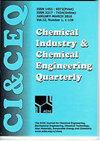Xanthomonas campestris biocontrol agent: Selection, medium formulation and bioprocess kinetic analysis
IF 0.8
4区 工程技术
Q4 CHEMISTRY, APPLIED
Chemical Industry & Chemical Engineering Quarterly
Pub Date : 2021-01-01
DOI:10.2298/ciceq200508032g
引用次数: 8
Abstract
Black rot, caused by Xanthomonas campestris pv. campestris, is one of the most important diseases of cruciferous crops which causes significant yield losses. Biological control of black rot by microbial biocontrol agents represents a promising alternative to chemical treatments and good agricultural practices which show only limited success. This study was carried out to assess a potential of different antagonists, including Bacillus, Pseudomonas, Lactobacillus, Streptomyces, Saccharomyces and Trichoderma genera, for biological control of black rot. Cultivation broth samples and their filtrates were examined against seven X. campestris strains, isolated from diseased cruciferous plants, using the diffusion-disc method. Bacillus velezensis has showed the highest inhibition zone diameter of 35.62?3.76 mm. Afterwards, different combinations of carbon and nitrogen sources were used in the cultivation medium to maximize antagonistic activity of B. velezensis. The best combinations were glycerol and yeast extract, lactose and peptone, as well as sucrose and yeast extract, suggesting the potential of biodiesel, dairy and sugar industry effluents in the production of bioactive compounds effective against the black rot pathogen. The validation experiment was performed in a laboratory-scale bioreactor, in order to investigate bioprocess kinetics of biomass growth and carbon source consumption, using the cultivation medium containing the optimal carbon and nitrogen source.油菜黄单胞菌生物防治剂的选择、培养基配方及生物动力学分析
由油菜黄单胞菌引起的黑腐病。油菜病是十字花科作物的重要病害之一,造成严重的产量损失。微生物生物防治剂对黑腐病的生物防治是一种很有前途的替代化学处理和良好农业规范的方法,这些方法仅显示出有限的成功。本研究评估了芽孢杆菌、假单胞菌、乳酸杆菌、链霉菌、酵母菌和木霉属等不同拮抗剂对黑腐病的生物防治潜力。采用扩散盘法检测了从患病十字花科植物中分离的7株campestris菌株的培养液及其滤液。velezensis的最大抑菌带直径为35.62 ~ 3.76 mm。然后,在培养基中使用不同的碳氮源组合,以最大限度地提高白僵菌的拮抗活性。最佳组合为甘油和酵母提取物、乳糖和蛋白胨以及蔗糖和酵母提取物,这表明生物柴油、乳制品和制糖工业废水在生产有效防治黑腐病病原体的生物活性化合物方面具有潜力。为了研究生物质生长和碳源消耗的生物过程动力学,在实验室规模的生物反应器中进行了验证实验,使用含有最佳碳氮源的培养基。
本文章由计算机程序翻译,如有差异,请以英文原文为准。
求助全文
约1分钟内获得全文
求助全文
来源期刊

Chemical Industry & Chemical Engineering Quarterly
CHEMISTRY, APPLIED-ENGINEERING, CHEMICAL
CiteScore
2.10
自引率
0.00%
发文量
24
审稿时长
3.3 months
期刊介绍:
The Journal invites contributions to the following two main areas:
• Applied Chemistry dealing with the application of basic chemical sciences to industry
• Chemical Engineering dealing with the chemical and biochemical conversion of raw materials into different products as well as the design and operation of plants and equipment.
The Journal welcomes contributions focused on:
Chemical and Biochemical Engineering [...]
Process Systems Engineering[...]
Environmental Chemical and Process Engineering[...]
Materials Synthesis and Processing[...]
Food and Bioproducts Processing[...]
Process Technology[...]
 求助内容:
求助内容: 应助结果提醒方式:
应助结果提醒方式:


